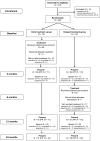The Efficacy of Doxycycline Treatment on Mansonella perstans Infection: An Open-Label, Randomized Trial in Ghana
- PMID: 31162017
- PMCID: PMC6609185
- DOI: 10.4269/ajtmh.18-0491
The Efficacy of Doxycycline Treatment on Mansonella perstans Infection: An Open-Label, Randomized Trial in Ghana
Abstract
Treating Mansonella perstans is challenged by the low efficacy of registered antihelminthics. Wolbachia endobacteria provide an alternative treatment target because depletion results in amicrofilaremia in filarial infections with Wuchereria bancrofti and Onchocerca volvulus infections. This open-label, randomized study sought to confirm that i) Wolbachia are present in M. perstans in Ghana and ii) doxycycline treatment will deplete Wolbachia and cause a slow, sustained decline in microfilariae (MF). Two hundred and two Ghanaians with M. perstans infection were randomized into early (immediate) and delayed (6 months deferred) treatment groups, given doxycycline 200 mg/day for 6 weeks, and monitored for MF and Wolbachia levels at baseline, 4, 12, and 24 months after the study onset (= time of randomization and start of treatment for the early group). Per protocol analysis revealed that the median MF/mL in the early group declined from 138 at baseline to 64 at month 4 and further to 0 at month 12. In the delayed group, MF load did not change from a baseline median of 97 to 102 at month 4 but declined to 42 at month 12, that is, 6 months after receiving treatment, trailing the early group as expected. By month 24, both treatment groups had reached a median MF level of 0. After treatment, Wolbachia were depleted from MF by ≥ 1-log drop compared with baseline levels. We conclude that M. perstans in Ghana harbor Wolbachia that are effectively depleted by doxycycline with subsequent reduction in MF loads, most likely because of interruption of fertility of adult worms.
Figures


Similar articles
-
A randomized trial of doxycycline for Mansonella perstans infection.N Engl J Med. 2009 Oct 8;361(15):1448-58. doi: 10.1056/NEJMoa0900863. N Engl J Med. 2009. PMID: 19812401 Free PMC article. Clinical Trial.
-
Doxycycline for Mansonella perstans infection.N Engl J Med. 2010 Jan 21;362(3):272; author reply 272-3. doi: 10.1056/NEJMc0910675. N Engl J Med. 2010. PMID: 20089982 No abstract available.
-
Mansonella perstans--the importance of an endosymbiont.N Engl J Med. 2009 Oct 8;361(15):1502-4. doi: 10.1056/NEJMe0905193. N Engl J Med. 2009. PMID: 19812409 No abstract available.
-
Doxycycline Treatment of Mansonella perstans-Infected Individuals Affects Immune Cell Activation and Causes Long-term T-cell Polarization.Clin Infect Dis. 2023 Feb 8;76(3):e1399-e1407. doi: 10.1093/cid/ciac428. Clin Infect Dis. 2023. PMID: 35657028 Clinical Trial.
-
Mansonella perstans filariasis in Africa.Acta Trop. 2011 Sep;120 Suppl 1:S109-20. doi: 10.1016/j.actatropica.2010.01.014. Epub 2010 Feb 10. Acta Trop. 2011. PMID: 20152790 Review.
Cited by
-
An Overview of the Management of Mansonellosis.Res Rep Trop Med. 2021 May 24;12:93-105. doi: 10.2147/RRTM.S274684. eCollection 2021. Res Rep Trop Med. 2021. PMID: 34079424 Free PMC article. Review.
-
Albendazole and Mebendazole as Anti-Parasitic and Anti-Cancer Agents: an Update.Korean J Parasitol. 2021 Jun;59(3):189-225. doi: 10.3347/kjp.2021.59.3.189. Epub 2021 Jun 21. Korean J Parasitol. 2021. PMID: 34218593 Free PMC article. Review.
-
Wolbachia bacteria in Mansonella perstans isolates from patients infected in different geographical areas: a pilot study from the ESCMID Study Group for Clinical Parasitology.Parasit Vectors. 2025 Mar 10;18(1):97. doi: 10.1186/s13071-025-06723-0. Parasit Vectors. 2025. PMID: 40065479 Free PMC article.
-
Filarial disease in the Brazilian Amazon and emerging opportunities for treatment and control.Curr Res Parasitol Vector Borne Dis. 2023 Dec 23;5:100168. doi: 10.1016/j.crpvbd.2023.100168. eCollection 2024. Curr Res Parasitol Vector Borne Dis. 2023. PMID: 38283060 Free PMC article. Review.
-
Performance of two serodiagnostic tests for loiasis in a Non-Endemic area.PLoS Negl Trop Dis. 2020 May 26;14(5):e0008187. doi: 10.1371/journal.pntd.0008187. eCollection 2020 May. PLoS Negl Trop Dis. 2020. PMID: 32453734 Free PMC article.
References
-
- Wanji S, Tendongfor N, Esum M, Ndindeng S, Enyong P, 2003. Epidemiology of concomitant infections due to Loa loa, Mansonella perstans, and Onchocerca volvulus in rain forest villages of Cameroon. Med Microbiol Immunol 192: 15–21. - PubMed
-
- Akue JP, Hommel M, Devaney E, 1996. Markers of Loa loa infection in permanent residents of a loiasis endemic area of Gabon. Trans R Soc Trop Med Hyg 90: 115–118. - PubMed
-
- Simonsen PE, Onapa AW, Asio SM, 2011. Mansonella perstans filariasis in Africa. Acta Trop 120 (Suppl 1): S109–S120. - PubMed
Publication types
MeSH terms
Substances
Grants and funding
LinkOut - more resources
Full Text Sources
Medical

